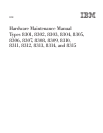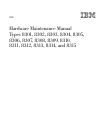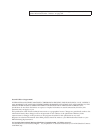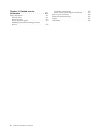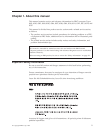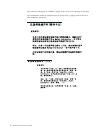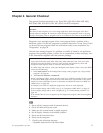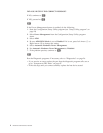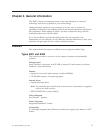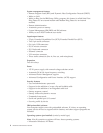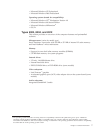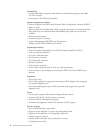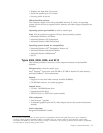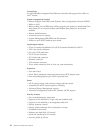
Chapter
2.
General
Checkout
This
general
checkout
procedure
is
for
Types
8301,
8302,
8303,
8304,
8305,
8306,
8307,
8308,
8309,
8310,
8311,
8312,
8313,
8314,
and
8315
computers.
Attention:
The
drives
in
the
computer
you
are
servicing
might
have
been
rearranged
or
the
drive
startup
sequence
changed.
Be
extremely
careful
during
write
operations
such
as
copying,
saving
or
formatting.
Data
or
programs
can
be
overwritten
if
you
select
an
incorrect
drive.
Diagnostic
error
messages
appear
when
a
test
program
finds
a
problem
with
a
hardware
option.
For
the
test
programs
to
properly
determine
if
a
test
Passed,
Failed
or
Aborted,
the
test
programs
check
the
error-return
code
at
test
completion.
See
“Diagnostics”
on
page
26.
General
error
messages
appear
if
a
problem
or
conflict
is
found
by
an
application
program,
the
operating
system,
or
both.
For
an
explanation
of
these
messages,
refer
to
the
information
supplied
with
that
software
package.
Notes:
v
Types
8301,
8302,
8303,
8304,
8305,
8306,
8307,
8308,
8309,
8310,
8311,
8312,
8313,
8314,
and
8315
computers
default
to
come
up
quiet
(no
beep
and
no
memory
count
and
checkpoint
code
display)
when
no
errors
are
detected
by
POST.
v
To
enable
beep
and
memory
count
and
checkpoint
code
display
when
a
successful
POST
occurs,
do
the
following:
1.
Select
Start
Options
in
the
Configuration/Setup
Utility
program
(see
“Setup
Utility
program”
on
page
24).
2.
Set
Power-On
Self-Test
to
Enhanced.
v
Before
replacing
any
FRUs,
ensure
that
the
latest
level
of
BIOS
is
installed
on
the
system.
A
down-level
BIOS
might
cause
false
errors
and
unnecessary
replacement
of
the
system
board.
For
more
information
on
how
to
determine
and
obtain
the
latest
level
BIOS,
see
“BIOS
levels”
on
page
265.
v
If
multiple
error
codes
are
displayed,
diagnose
the
first
error
code
displayed.
v
If
the
computer
hangs
with
a
POST
error,
go
to
″Symptom-to-FRU
Index″
on
page
87.
v
If
the
computer
hangs
and
no
error
is
displayed,
go
to
“Undetermined
problems”
on
page
127.
v
If
an
installed
device
is
not
recognized
by
the
diagnostics
program,
that
device
might
be
defective.
001
1.
Power-off
the
computer
and
all
external
devices.
2.
Check
all
cables
and
power
cords.
3.
Make
sure
the
system
board
is
seated
properly.
4.
Set
all
display
controls
to
the
middle
position.
5.
Power-on
all
external
devices.
6.
Power-on
the
computer.
7.
Check
for
the
following
response:
v
Readable
instructions
or
the
Main
Menu.
©
Copyright
IBM
Corp.
2001
3



